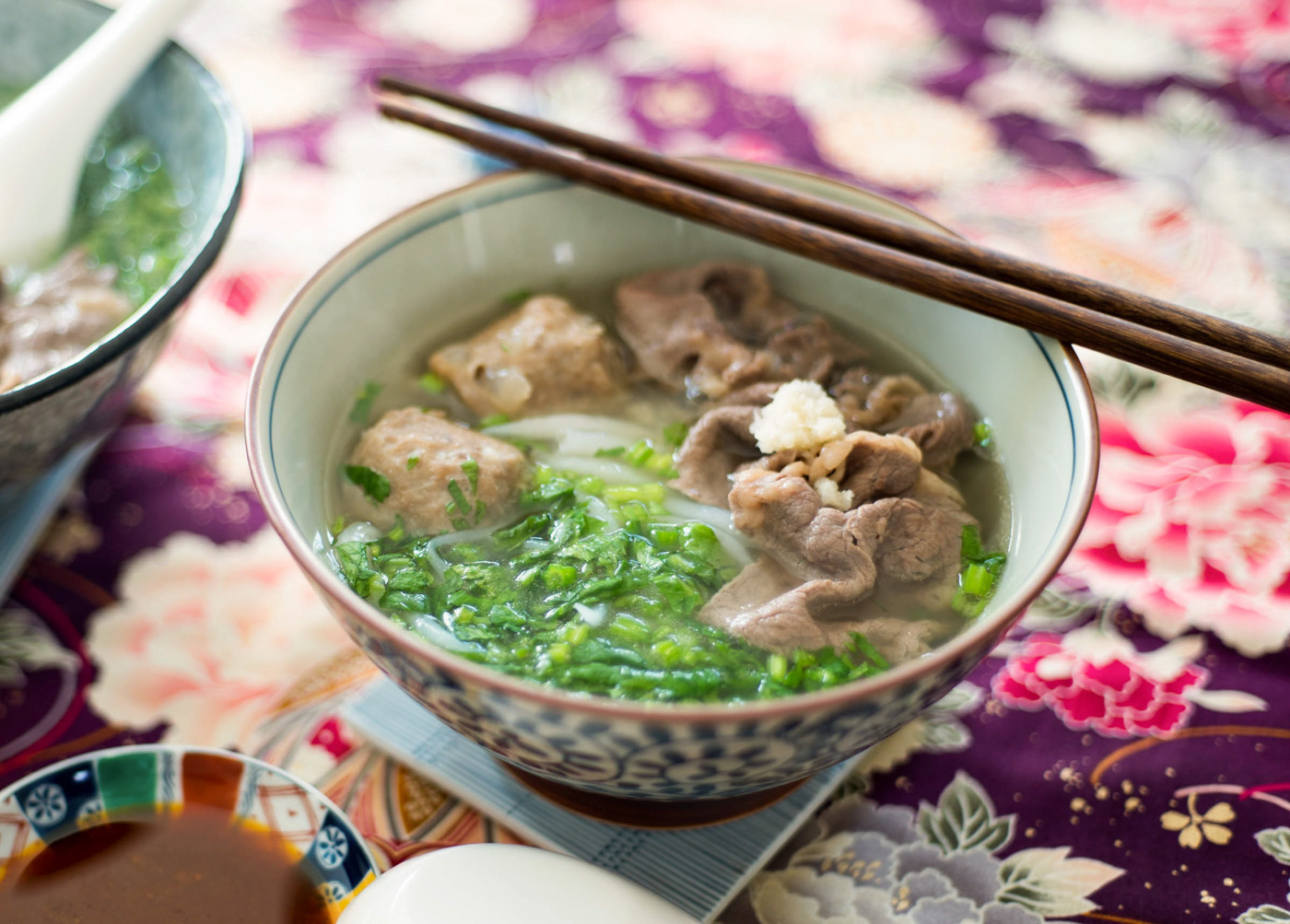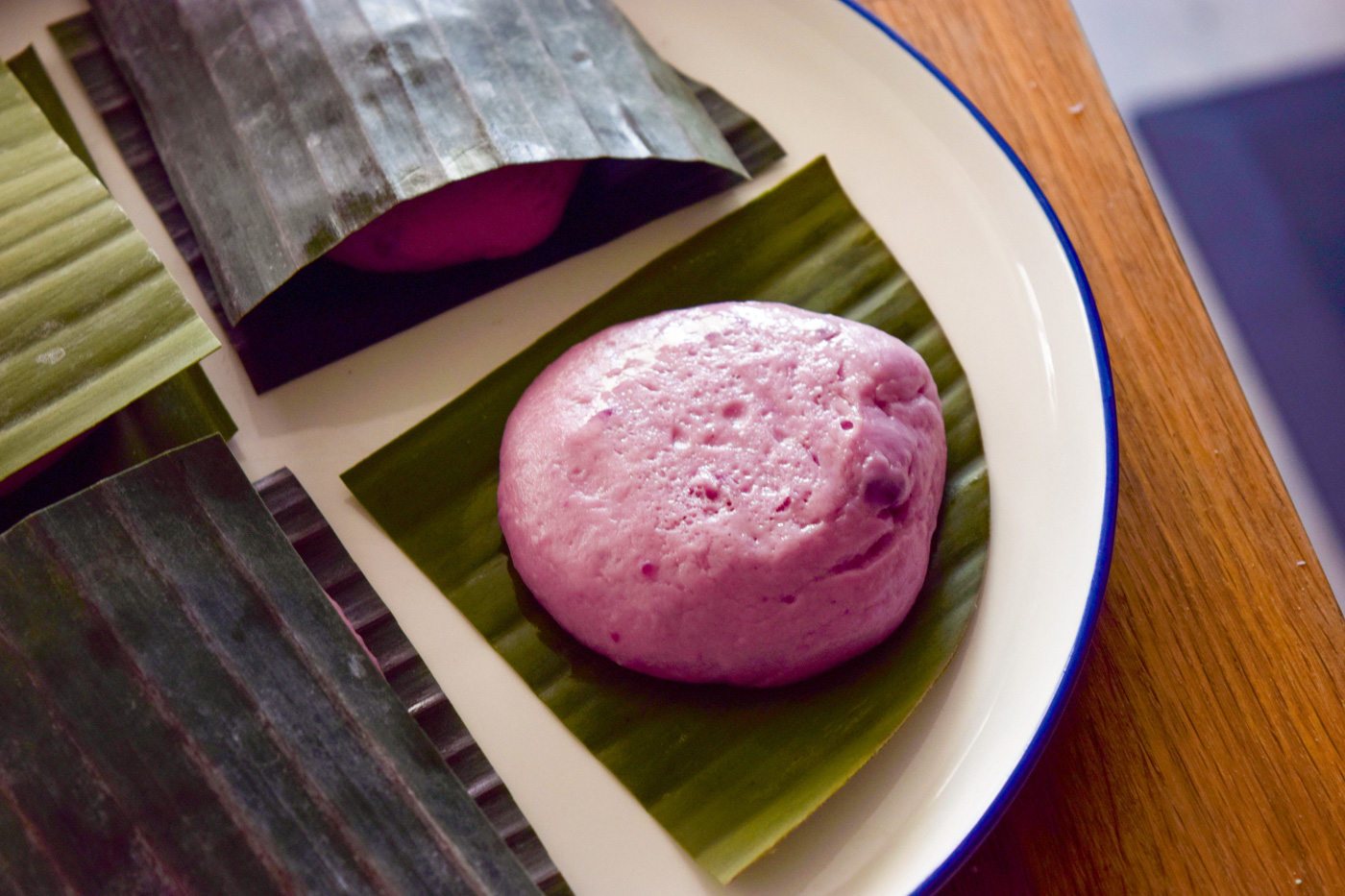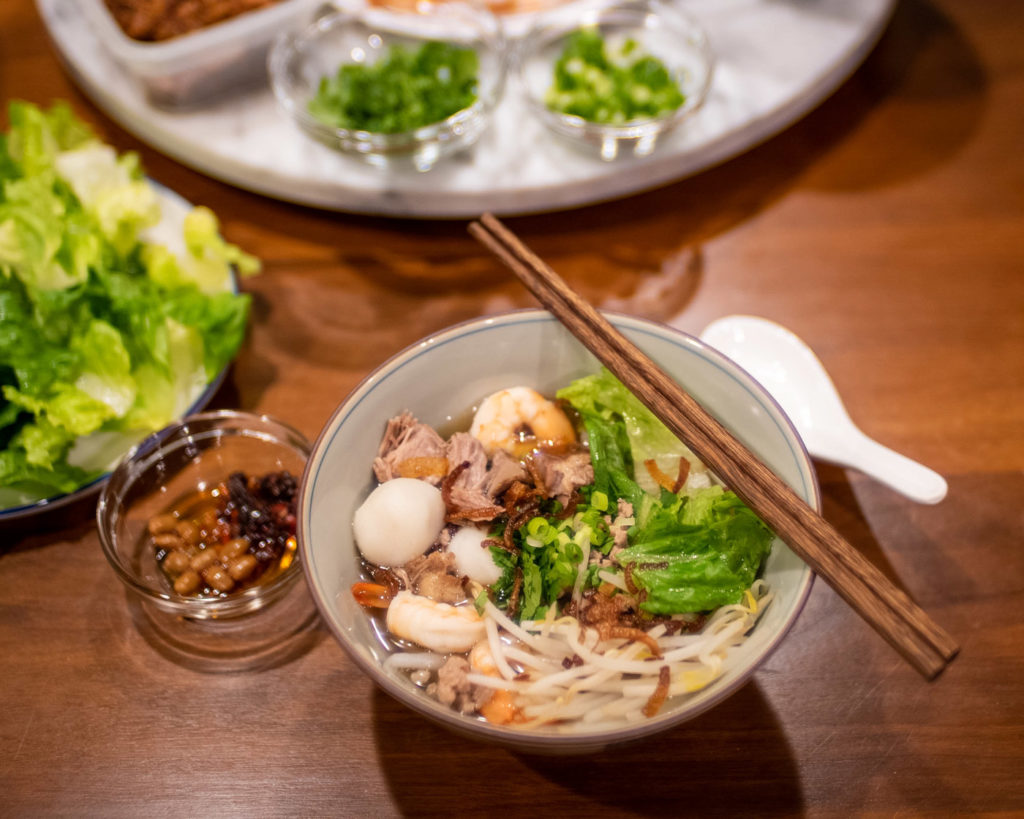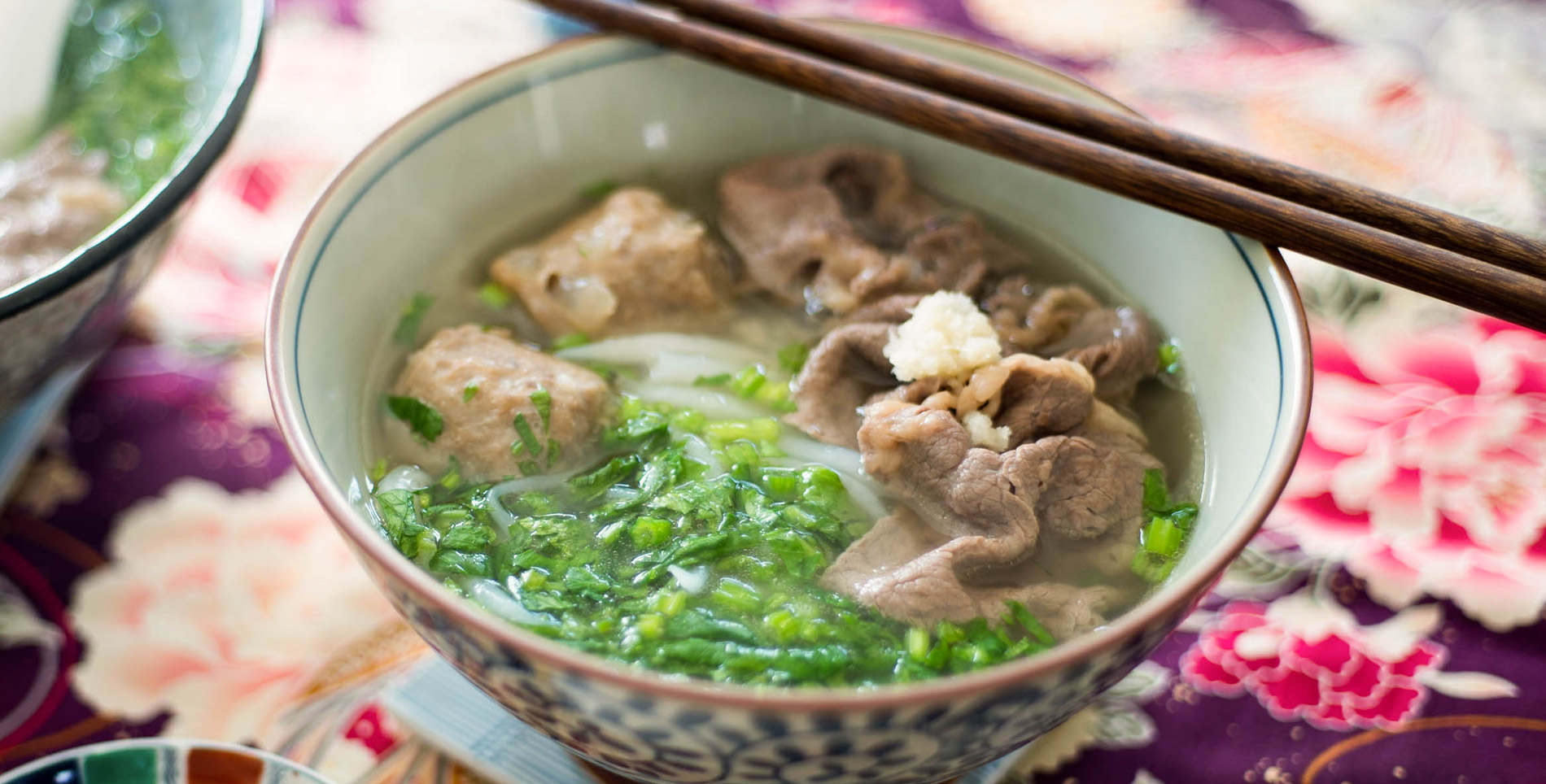This story is published in partnership with KCET / PBS SoCal.
If you’re familiar with Sriracha, you know something with Teochew roots. The famous rooster brand chili sauce by Huy Fong Foods was developed by David Tran, a Vietnamese refugee of Teochew descent.
Before he left Vietnam in 1978 around the age of 33, Tran made his own hot sauce, a common practice for many households. During the war, he served as a major in the South Vietnamese army. But in 1978, he fled communist Vietnam with over 3,000 other refugees on a Taiwanese-owned freighter called Huey Fong, which eventually became the namesake of his company. Tran arrived in the United States in 1979, and while looking for a job, he continued to tinker with his hot sauce recipe and eventually began selling it. Today, the sauce is world famous. Although hot sauce isn’t uniquely Teochew in origin, what is remarkably Teochew is Tran’s journey — cultural survival through food is a recurring theme for our people.
Despite an estimated global population of 25 million, Teochew — sometimes spelled Chiu Chow or Chaozhou — people are invisible to much of the world. Across many generations, our people have migrated and adapted. Even my own identity as Vietnamese and Teochew stems from my grandparents’ ability to adapt to Vietnamese culture. The Teochew language is one of over 2,000 Asian languages, yet this diversity is not well-known because there are more dominant cultural categories and labels like Cambodian, Chinese or Taiwanese. Although Teochew people may seem large in number, the price of becoming a globalized people is heavy and was rarely, if ever, by choice. From local to global conflicts, we have survived generations of displacement. But migration, distinctive cuisine and intergenerational storytelling have kept our culture alive for generations.

From Ancestral Home To Global Diaspora
For Teochew people, diaspora fully describes our generational and geographical scatter. The origin story of our people is a complex and challenging one. Our ancestral roots can be traced to the Yellow River Valley in the Central Plains of China. Due to civil wars during the Jin dynasty (265 to 420 A.D.), our people fled and eventually migrated through the mountains of Fujian toward a coastal region of Guangdong, China, called Teoswa (or Chaoshan in Mandarin). This region is considered the Teochew homeland. But despite having a place to call home, over time, more displacement and migration occurred as more local conflicts arose.
Teochew people have been pushed and pulled to the corners of the world. Today, it’s estimated that half of all Teochew people live outside of China across countless countries with significant presences in Southeast Asia. As our people migrate, cultural exchange is key to surviving and thriving. “Teochew people, for some reason, speak every language,” says Benjamin Tran, a policy advocate in Sacramento, California. “My parents speak Mandarin, Cantonese, Vietnamese, and a bit English on top of Teochew.” Tran believes the Teochew’s diasporic nature allows us to claim many identities, including Cambodian, Vietnamese and Malaysian, to name a few.
In the last half century, by way of Southeast Asia, refugees of Teochew descent arrived to North America, Europe and Australia as the direct consequence of the Vietnam War and the Khmer Rouge genocide. The latter was the systematic persecution and killing of Cambodians under the Pol Pot dictatorship where upward to 2 million people were killed from 1975 to 1979. Those who were ethnically Chinese Cambodians, like Teochew people, were specifically targeted.
These geopolitical movements have influenced how we see ourselves. “I’m Teochew Cambodian and was raised by my maternal grandmother,” says Julie Lai, who speaks Teochew and Khmer (Cambodian). “Growing up, I felt like I had an identity crisis. Being Teochew, I felt invisible. Besides my cousins, I didn’t know anyone else like me.” In fact, while going to school in Central Alberta, Canada, Lai was placed into bilingual Mandarin and English classes. Yet, most of her peers spoke Cantonese. This is a common situation in educational systems not equipped to meet the cultural and linguistic needs of students.
Like many displaced peoples who experience psychological trauma, Teochew people struggle with understanding our identities. Sometimes the past is hard to talk about, or simply there are more dominant languages. Worldwide, Teochew people have very diverse identity experiences. Some are born knowing their Teochew culture, while others, like me, discover it over time. “I was raised Teochew and so were my cousins in America,” says G.C., an engineer from New York City. “But my cousins in Germany identify as Vietnamese and don’t know the Teochew language.”
How It Started
Over Zoom, longtime friends Lauren Delgado and Rayson Esquejo, both second-generation Filipino Americans, tell me they launched the Manila District in July of 2020 in response to the pandemic. In the mid- to late-2010s, Filipino cuisine was having its long overdue moment on a national level. Filipino American chefs and restaurateurs like Angela Dimayuga, Nicole Ponseca and Tom Cunanan were garnering James Beard nominations and awards. Filipino chefs like Yana Gilbuena, Chad and Chase Valencia, and Isa Fabro were being featured regularly in The New York Times, Los Angeles Times, The Washington Post, Bon Appétit, Eater and on the Food Network.
But with the coronavirus lockdown came the sudden closure of restaurants and food events, like Smorgasburg and 626 Night Market, where many up-and-coming Filipino Americans chefs, including Lobsterdamus’s Johnny Angeles and Francis Reyes, had established their pop-ups. The momentum of the Filipino food movement came to a screeching halt, and Delgado and Esquejo felt they needed to do something. But they weren’t sure how, at first.

Despite identity challenges, wonderful new cultures have emerged, particularly through food as Teochew people migrate to other countries and learn new cuisines. Regardless of where we are in the world, Teochew people have a special greeting when we see each other. We say, “Gaginang,” meaning, “We are one.” Promptly followed by, “Have you eaten yet?” Our food, like our people, has adapted to the cultures around us with local ingredients and techniques. We have interpreted and blended cultures to create unique and popular dishes enjoyed by many worldwide.
Adaptive Teochew Cuisine
There is a reason why the first season of Netflix’s “Flavorful Origins” (2019) is focused on Teochew cuisine. The Teoswa (Chaoshan) region is known for its gastronomy, which is characterized by flavorfully balanced and vibrant dishes, free of heavy seasoning. Teochew cooking methods include poaching, steaming, braising and stir-frying. Since Teoswa sits in a coastal region, seafood is a popular hero in a number of dishes. There are well-known Teochew dishes and food items that many people may not know originate from our people. A few dishes include gue diao (Teochew noodle soup), hiam jio iu (Teochew chili oil), hung gue (Teochew dumplings), ghu bhah in (Teochew beef meatballs), and gue (Teochew snacks).
Gue diao, a rice noodle dish, is prepared with a light, clear pork bone broth with minced meat and shrimp. This popular combination originated from Cambodian-Vietnamese Teochew people. In Vietnamese, it’s spelled Hủ tiếu Nam Vang, named after the Vietnamese name for Cambodia’s capital, Phnom Penh (Nam Vang). It’s also named for its Teochew long-grain rice flour noodles, called kway teow in Khmer and hủ tiếu in Vietnamese. Since the noodles are not made of glutinous rice flour, this difference gives the noodles a translucent look with a chewy, springy bite to them.

Hiam jio iu is Teochew chili oil, often labeled as such on glass jars, and is a staple pantry item available in most Asian markets under popular brands like Lee Kum Kee. This chili oil packs a punch with umami depth and layered heat. Many enjoy this chili oil on dumplings, vegetables, noodles or rice. In the jar, you’ll notice dark pieces of chili and garlic sink and separate from the reddish-golden hues of the floating oil. This chili oil is believed to be inspired by food fusions between the Cantonese and Teochew peoples in the Guangdong province.
Hung gue, Teochew dumplings, are another Cantonese-Teochew hybrid. Known as fun guo in Cantonese, they are translucent tapioca-based dumplings with textured fillings of minced pork, shrimp, peanuts, chives, garlic and water chestnut. Amid bustling dim sum scenes, these dumplings can be found with their popular cuisine cousins, har gow and siu mai.
Ghu bhah in, Teochew beef meatballs, can be found in a number of Asian hot pot spots or in bowls of Vietnamese phở. They are made by pounding meat, which stretches the protein strands. Pieces of tendon are later added to provide a chewy texture. And after rolling out the meatballs and applying some heat, they are soup-ready. A similar process is used for Japanese surimi, a seafood product commonly marketed as imitation crab.
Although a broad term, gue are bite-sized snacking morsels and can be sweet or savory. Popularly known as kueh in Singapore and Malaysia, they usually consist of rice flour or tapioca starches. Due to the global migration of Teochew people and regional differences, gue has been adapted over time to include locally available ingredients. For instance, the migration of Teochew people from China to Southeast Asia has resulted in coconut and pandan as gue flavors.

Sharing Stories, Preserving Culture
With the cost of geographic displacement, the legacy of our culture survives through our food. The global migration of our people has split families and severed connections to our ancestral roots. As our culture is being passed down from generation to generation, Teochew cuisine is our generational wealth. If our food endures, then it should also be accompanied by written and visual narratives, as well as our spoken ancestral language. Inclusive narratives keep cultures alive.
That’s why it’s so important for Teochew people to tell our stories as much as for non-Teochew people to experience them. Diana Zheng didn’t set out to be a Teochew cookbook writer or historian, but she has written one of the very few existing English-language Teochew cookbooks called “Jia! The Food of Swatow and the Teochew Diaspora.” “There is not a singular Teochew experience because we’re such a global people,” Zheng tells me. “It gets confusing because there is no clean narrative of how we made our way across the globe.” That’s why Teochew authors and creatives like Zheng are so critical. As storytellers, they are documenting our existence through history and cuisine.

Knowledge of Teochew culture isn’t just important to our people, but to all people because cultural preservation is interconnected. If you are reading this and you’re not Teochew, you might be learning about an entire population for the first time. If you are Teochew, hopefully reading this resonates with you in a way that helps carry on our culture. Preserving culture is our collective responsibility, and it can be a delicious journey.







Our comments section is for members only.
Join today to gain exclusive access.